Corporate Finance Assignment: Mini-Cases, Car Loans, Outsourcing
VerifiedAdded on 2022/09/18
|11
|1278
|39
Homework Assignment
AI Summary
This document provides a comprehensive analysis of several corporate finance mini-cases. The first case examines the financial implications of outsourcing customer service to a foreign company, calculating and comparing the Net Present Value (NPV) of outsourcing versus keeping customer service i...
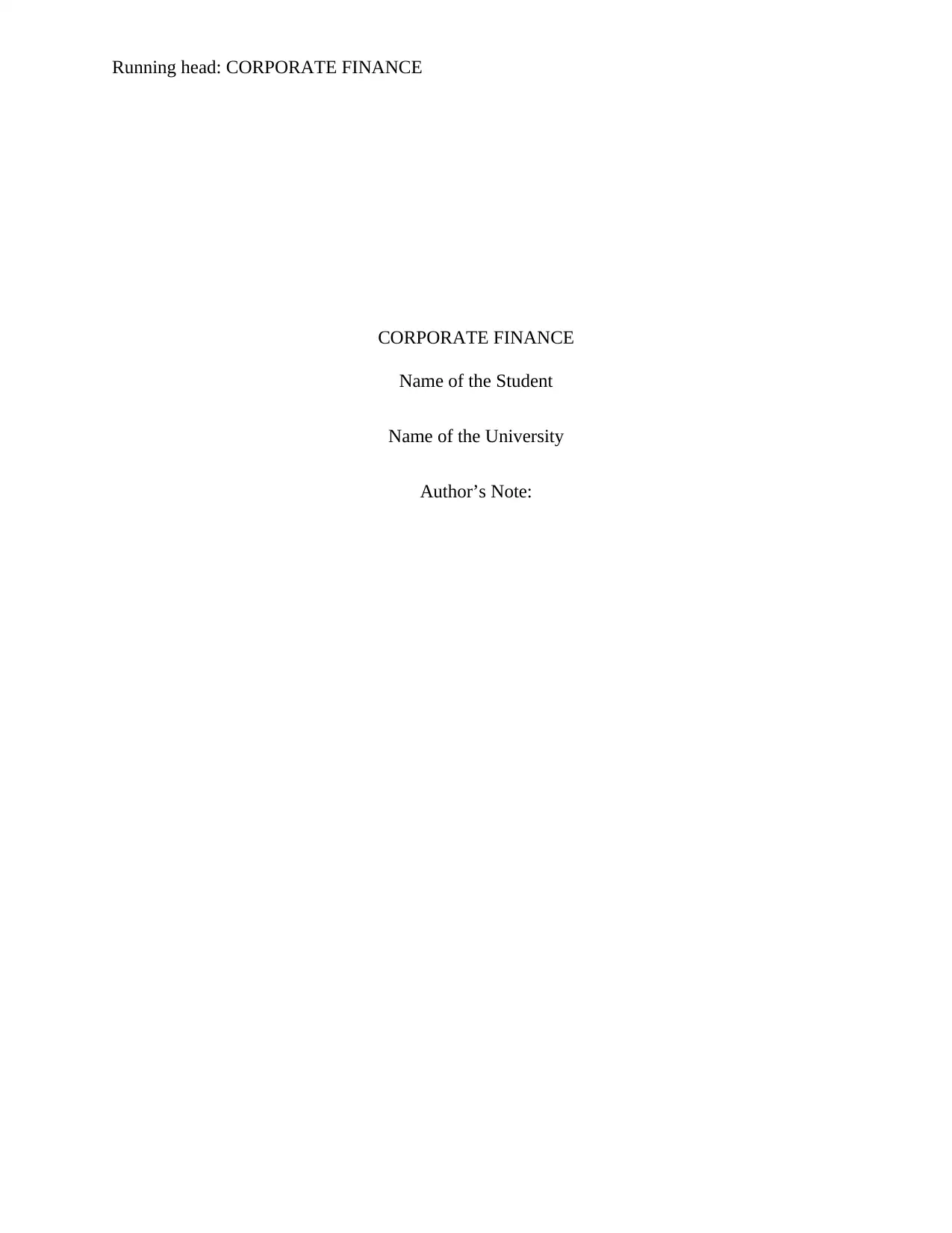
Running head: CORPORATE FINANCE
CORPORATE FINANCE
Name of the Student
Name of the University
Author’s Note:
CORPORATE FINANCE
Name of the Student
Name of the University
Author’s Note:
Paraphrase This Document
Need a fresh take? Get an instant paraphrase of this document with our AI Paraphraser
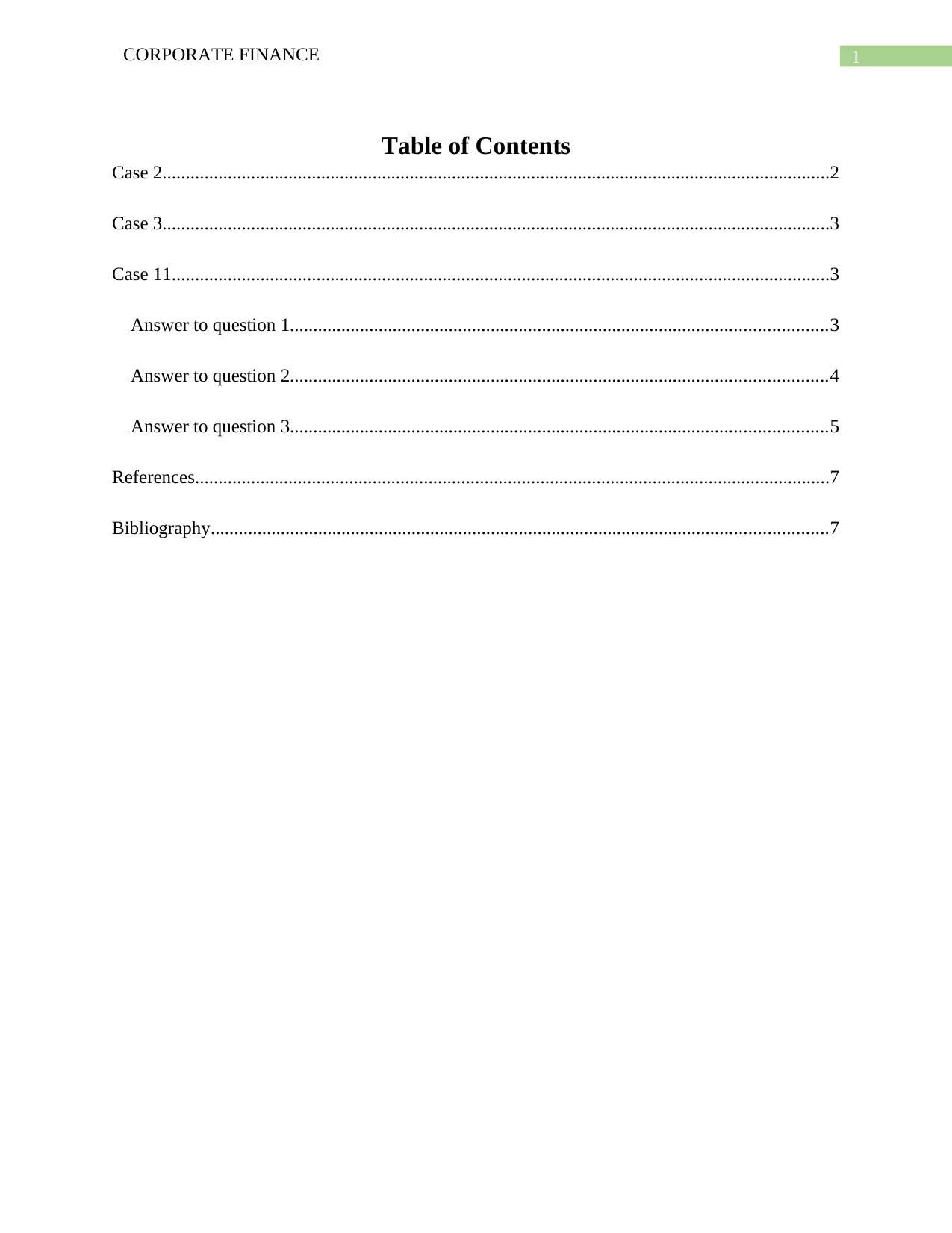
1CORPORATE FINANCE
Table of Contents
Case 2...............................................................................................................................................2
Case 3...............................................................................................................................................3
Case 11.............................................................................................................................................3
Answer to question 1...................................................................................................................3
Answer to question 2...................................................................................................................4
Answer to question 3...................................................................................................................5
References........................................................................................................................................7
Bibliography....................................................................................................................................7
Table of Contents
Case 2...............................................................................................................................................2
Case 3...............................................................................................................................................3
Case 11.............................................................................................................................................3
Answer to question 1...................................................................................................................3
Answer to question 2...................................................................................................................4
Answer to question 3...................................................................................................................5
References........................................................................................................................................7
Bibliography....................................................................................................................................7
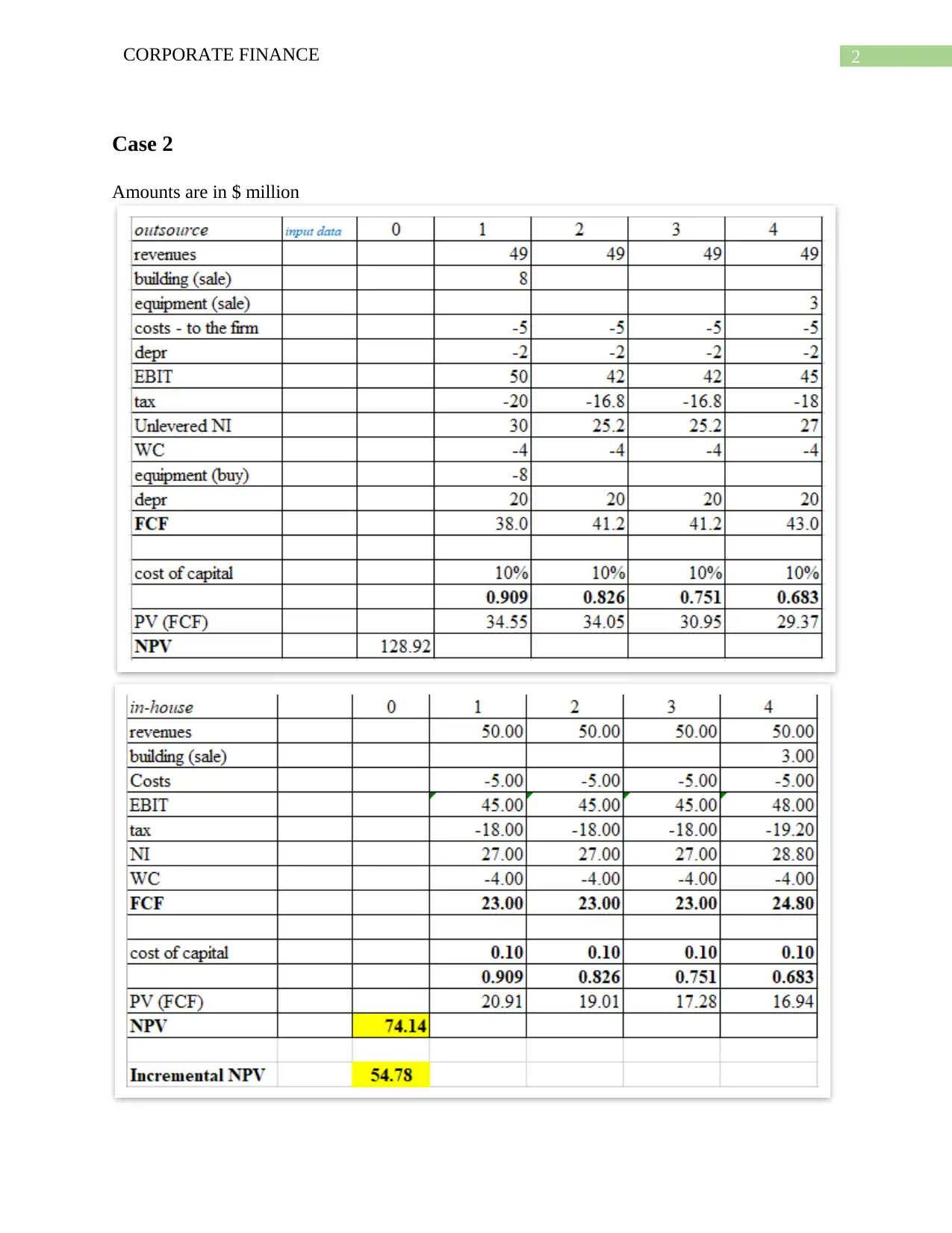
2CORPORATE FINANCE
Case 2
Amounts are in $ million
Case 2
Amounts are in $ million
You're viewing a preview
Unlock full access by subscribing today!
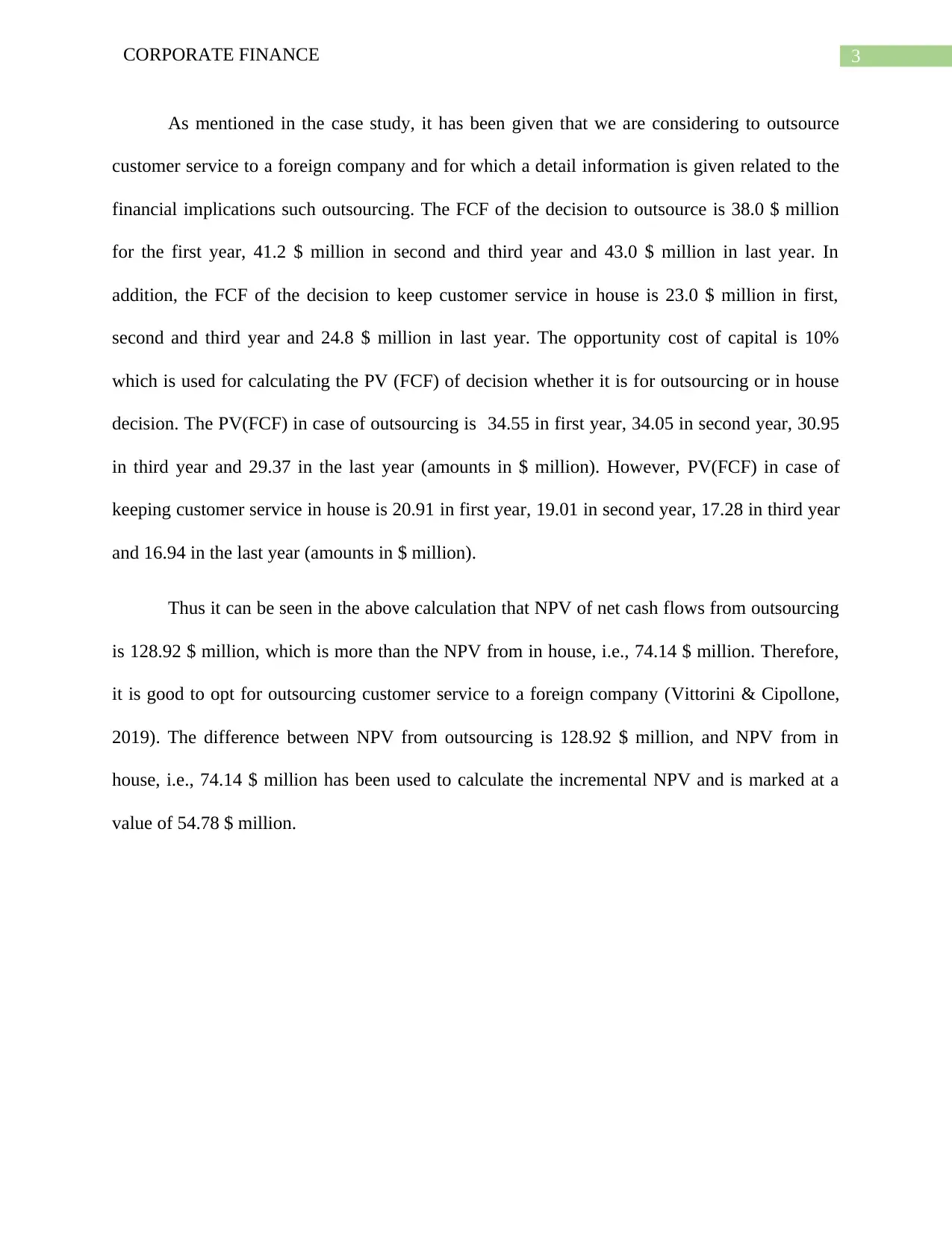
3CORPORATE FINANCE
As mentioned in the case study, it has been given that we are considering to outsource
customer service to a foreign company and for which a detail information is given related to the
financial implications such outsourcing. The FCF of the decision to outsource is 38.0 $ million
for the first year, 41.2 $ million in second and third year and 43.0 $ million in last year. In
addition, the FCF of the decision to keep customer service in house is 23.0 $ million in first,
second and third year and 24.8 $ million in last year. The opportunity cost of capital is 10%
which is used for calculating the PV (FCF) of decision whether it is for outsourcing or in house
decision. The PV(FCF) in case of outsourcing is 34.55 in first year, 34.05 in second year, 30.95
in third year and 29.37 in the last year (amounts in $ million). However, PV(FCF) in case of
keeping customer service in house is 20.91 in first year, 19.01 in second year, 17.28 in third year
and 16.94 in the last year (amounts in $ million).
Thus it can be seen in the above calculation that NPV of net cash flows from outsourcing
is 128.92 $ million, which is more than the NPV from in house, i.e., 74.14 $ million. Therefore,
it is good to opt for outsourcing customer service to a foreign company (Vittorini & Cipollone,
2019). The difference between NPV from outsourcing is 128.92 $ million, and NPV from in
house, i.e., 74.14 $ million has been used to calculate the incremental NPV and is marked at a
value of 54.78 $ million.
As mentioned in the case study, it has been given that we are considering to outsource
customer service to a foreign company and for which a detail information is given related to the
financial implications such outsourcing. The FCF of the decision to outsource is 38.0 $ million
for the first year, 41.2 $ million in second and third year and 43.0 $ million in last year. In
addition, the FCF of the decision to keep customer service in house is 23.0 $ million in first,
second and third year and 24.8 $ million in last year. The opportunity cost of capital is 10%
which is used for calculating the PV (FCF) of decision whether it is for outsourcing or in house
decision. The PV(FCF) in case of outsourcing is 34.55 in first year, 34.05 in second year, 30.95
in third year and 29.37 in the last year (amounts in $ million). However, PV(FCF) in case of
keeping customer service in house is 20.91 in first year, 19.01 in second year, 17.28 in third year
and 16.94 in the last year (amounts in $ million).
Thus it can be seen in the above calculation that NPV of net cash flows from outsourcing
is 128.92 $ million, which is more than the NPV from in house, i.e., 74.14 $ million. Therefore,
it is good to opt for outsourcing customer service to a foreign company (Vittorini & Cipollone,
2019). The difference between NPV from outsourcing is 128.92 $ million, and NPV from in
house, i.e., 74.14 $ million has been used to calculate the incremental NPV and is marked at a
value of 54.78 $ million.
Paraphrase This Document
Need a fresh take? Get an instant paraphrase of this document with our AI Paraphraser
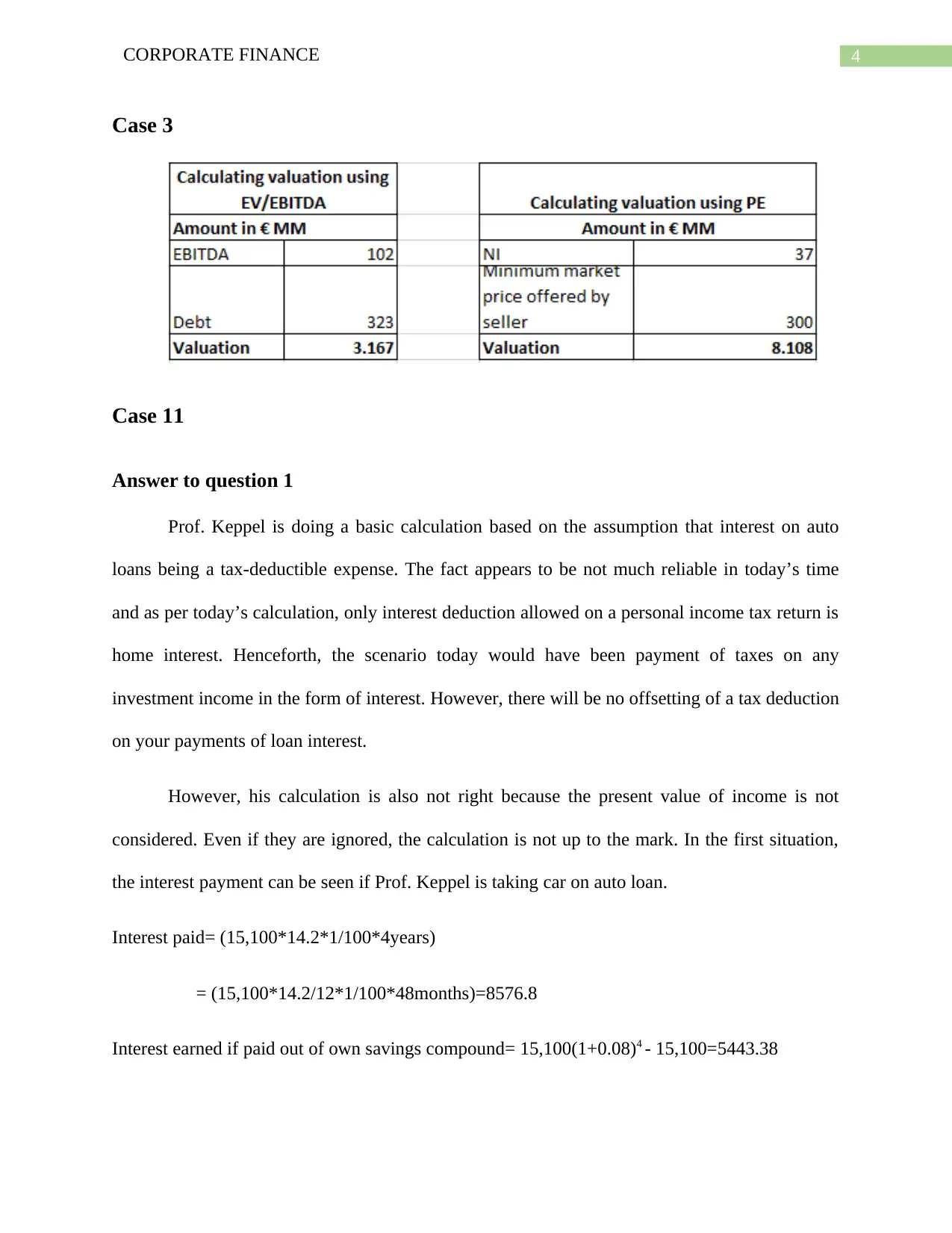
4CORPORATE FINANCE
Case 3
Case 11
Answer to question 1
Prof. Keppel is doing a basic calculation based on the assumption that interest on auto
loans being a tax-deductible expense. The fact appears to be not much reliable in today’s time
and as per today’s calculation, only interest deduction allowed on a personal income tax return is
home interest. Henceforth, the scenario today would have been payment of taxes on any
investment income in the form of interest. However, there will be no offsetting of a tax deduction
on your payments of loan interest.
However, his calculation is also not right because the present value of income is not
considered. Even if they are ignored, the calculation is not up to the mark. In the first situation,
the interest payment can be seen if Prof. Keppel is taking car on auto loan.
Interest paid= (15,100*14.2*1/100*4years)
= (15,100*14.2/12*1/100*48months)=8576.8
Interest earned if paid out of own savings compound= 15,100(1+0.08)4 - 15,100=5443.38
Case 3
Case 11
Answer to question 1
Prof. Keppel is doing a basic calculation based on the assumption that interest on auto
loans being a tax-deductible expense. The fact appears to be not much reliable in today’s time
and as per today’s calculation, only interest deduction allowed on a personal income tax return is
home interest. Henceforth, the scenario today would have been payment of taxes on any
investment income in the form of interest. However, there will be no offsetting of a tax deduction
on your payments of loan interest.
However, his calculation is also not right because the present value of income is not
considered. Even if they are ignored, the calculation is not up to the mark. In the first situation,
the interest payment can be seen if Prof. Keppel is taking car on auto loan.
Interest paid= (15,100*14.2*1/100*4years)
= (15,100*14.2/12*1/100*48months)=8576.8
Interest earned if paid out of own savings compound= 15,100(1+0.08)4 - 15,100=5443.38
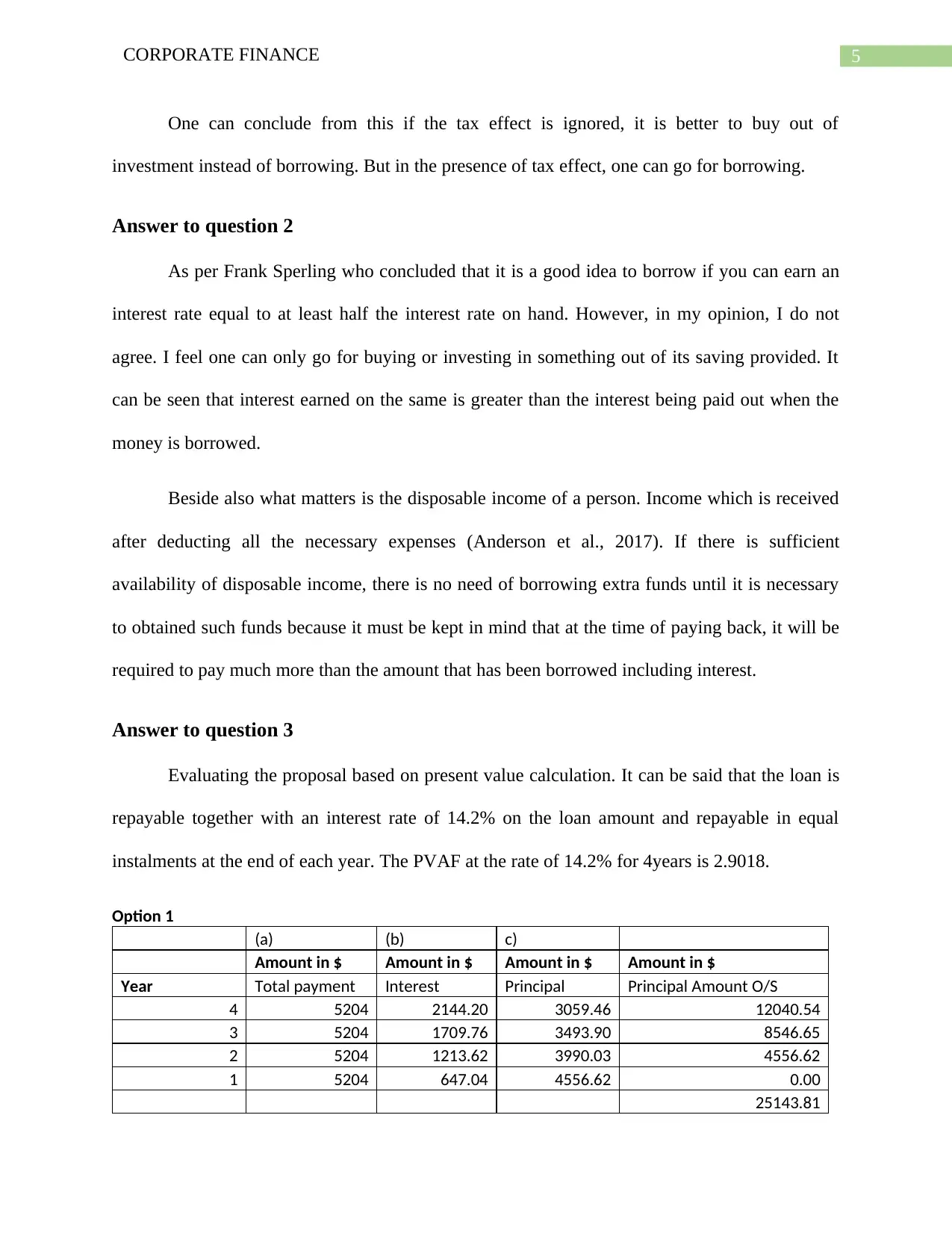
5CORPORATE FINANCE
One can conclude from this if the tax effect is ignored, it is better to buy out of
investment instead of borrowing. But in the presence of tax effect, one can go for borrowing.
Answer to question 2
As per Frank Sperling who concluded that it is a good idea to borrow if you can earn an
interest rate equal to at least half the interest rate on hand. However, in my opinion, I do not
agree. I feel one can only go for buying or investing in something out of its saving provided. It
can be seen that interest earned on the same is greater than the interest being paid out when the
money is borrowed.
Beside also what matters is the disposable income of a person. Income which is received
after deducting all the necessary expenses (Anderson et al., 2017). If there is sufficient
availability of disposable income, there is no need of borrowing extra funds until it is necessary
to obtained such funds because it must be kept in mind that at the time of paying back, it will be
required to pay much more than the amount that has been borrowed including interest.
Answer to question 3
Evaluating the proposal based on present value calculation. It can be said that the loan is
repayable together with an interest rate of 14.2% on the loan amount and repayable in equal
instalments at the end of each year. The PVAF at the rate of 14.2% for 4years is 2.9018.
Option 1
(a) (b) c)
Amount in $ Amount in $ Amount in $ Amount in $
Year Total payment Interest Principal Principal Amount O/S
4 5204 2144.20 3059.46 12040.54
3 5204 1709.76 3493.90 8546.65
2 5204 1213.62 3990.03 4556.62
1 5204 647.04 4556.62 0.00
25143.81
One can conclude from this if the tax effect is ignored, it is better to buy out of
investment instead of borrowing. But in the presence of tax effect, one can go for borrowing.
Answer to question 2
As per Frank Sperling who concluded that it is a good idea to borrow if you can earn an
interest rate equal to at least half the interest rate on hand. However, in my opinion, I do not
agree. I feel one can only go for buying or investing in something out of its saving provided. It
can be seen that interest earned on the same is greater than the interest being paid out when the
money is borrowed.
Beside also what matters is the disposable income of a person. Income which is received
after deducting all the necessary expenses (Anderson et al., 2017). If there is sufficient
availability of disposable income, there is no need of borrowing extra funds until it is necessary
to obtained such funds because it must be kept in mind that at the time of paying back, it will be
required to pay much more than the amount that has been borrowed including interest.
Answer to question 3
Evaluating the proposal based on present value calculation. It can be said that the loan is
repayable together with an interest rate of 14.2% on the loan amount and repayable in equal
instalments at the end of each year. The PVAF at the rate of 14.2% for 4years is 2.9018.
Option 1
(a) (b) c)
Amount in $ Amount in $ Amount in $ Amount in $
Year Total payment Interest Principal Principal Amount O/S
4 5204 2144.20 3059.46 12040.54
3 5204 1709.76 3493.90 8546.65
2 5204 1213.62 3990.03 4556.62
1 5204 647.04 4556.62 0.00
25143.81
You're viewing a preview
Unlock full access by subscribing today!
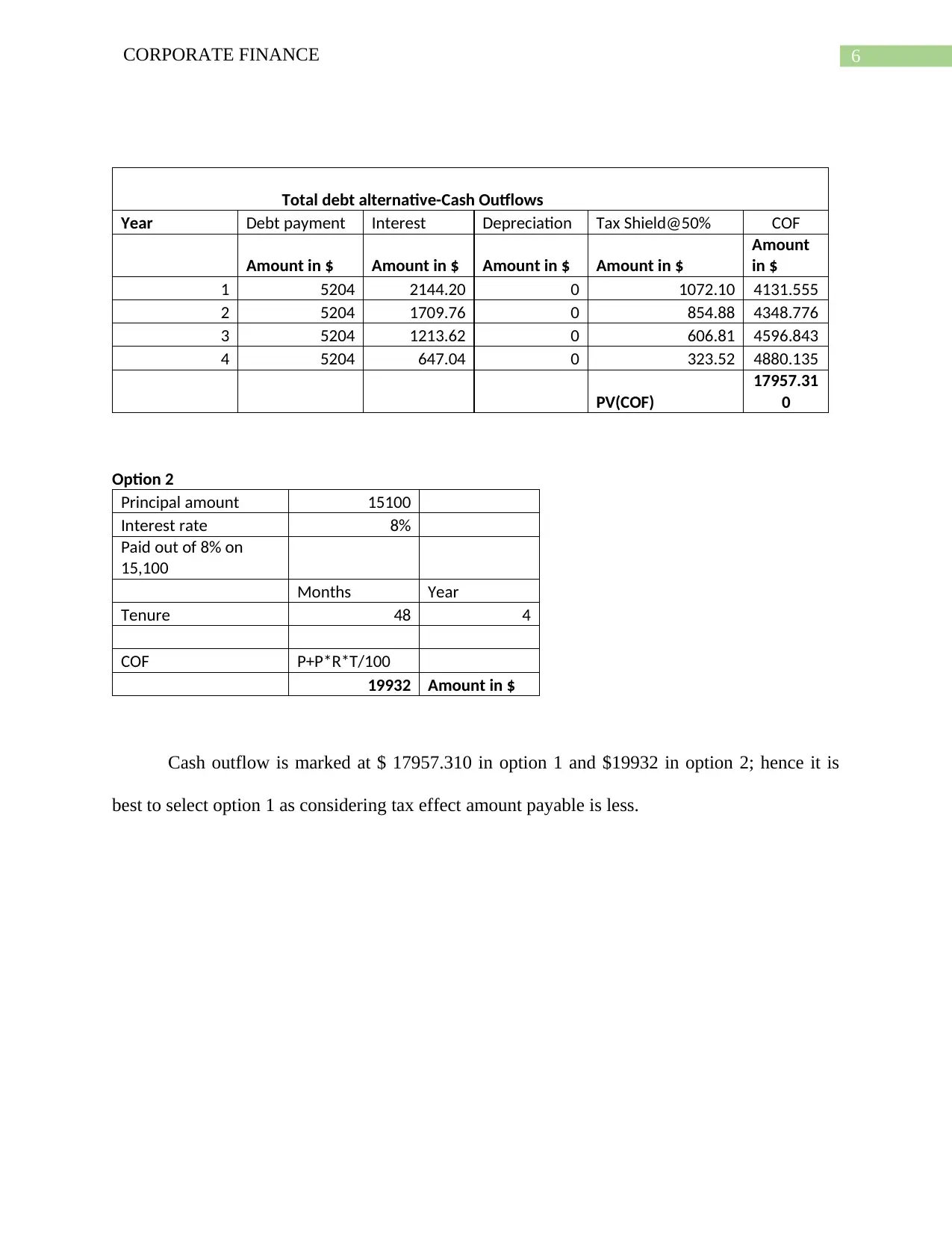
6CORPORATE FINANCE
Total debt alternative-Cash Outflows
Year Debt payment Interest Depreciation Tax Shield@50% COF
Amount in $ Amount in $ Amount in $ Amount in $
Amount
in $
1 5204 2144.20 0 1072.10 4131.555
2 5204 1709.76 0 854.88 4348.776
3 5204 1213.62 0 606.81 4596.843
4 5204 647.04 0 323.52 4880.135
PV(COF)
17957.31
0
Option 2
Principal amount 15100
Interest rate 8%
Paid out of 8% on
15,100
Months Year
Tenure 48 4
COF P+P*R*T/100
19932 Amount in $
Cash outflow is marked at $ 17957.310 in option 1 and $19932 in option 2; hence it is
best to select option 1 as considering tax effect amount payable is less.
Total debt alternative-Cash Outflows
Year Debt payment Interest Depreciation Tax Shield@50% COF
Amount in $ Amount in $ Amount in $ Amount in $
Amount
in $
1 5204 2144.20 0 1072.10 4131.555
2 5204 1709.76 0 854.88 4348.776
3 5204 1213.62 0 606.81 4596.843
4 5204 647.04 0 323.52 4880.135
PV(COF)
17957.31
0
Option 2
Principal amount 15100
Interest rate 8%
Paid out of 8% on
15,100
Months Year
Tenure 48 4
COF P+P*R*T/100
19932 Amount in $
Cash outflow is marked at $ 17957.310 in option 1 and $19932 in option 2; hence it is
best to select option 1 as considering tax effect amount payable is less.
Paraphrase This Document
Need a fresh take? Get an instant paraphrase of this document with our AI Paraphraser
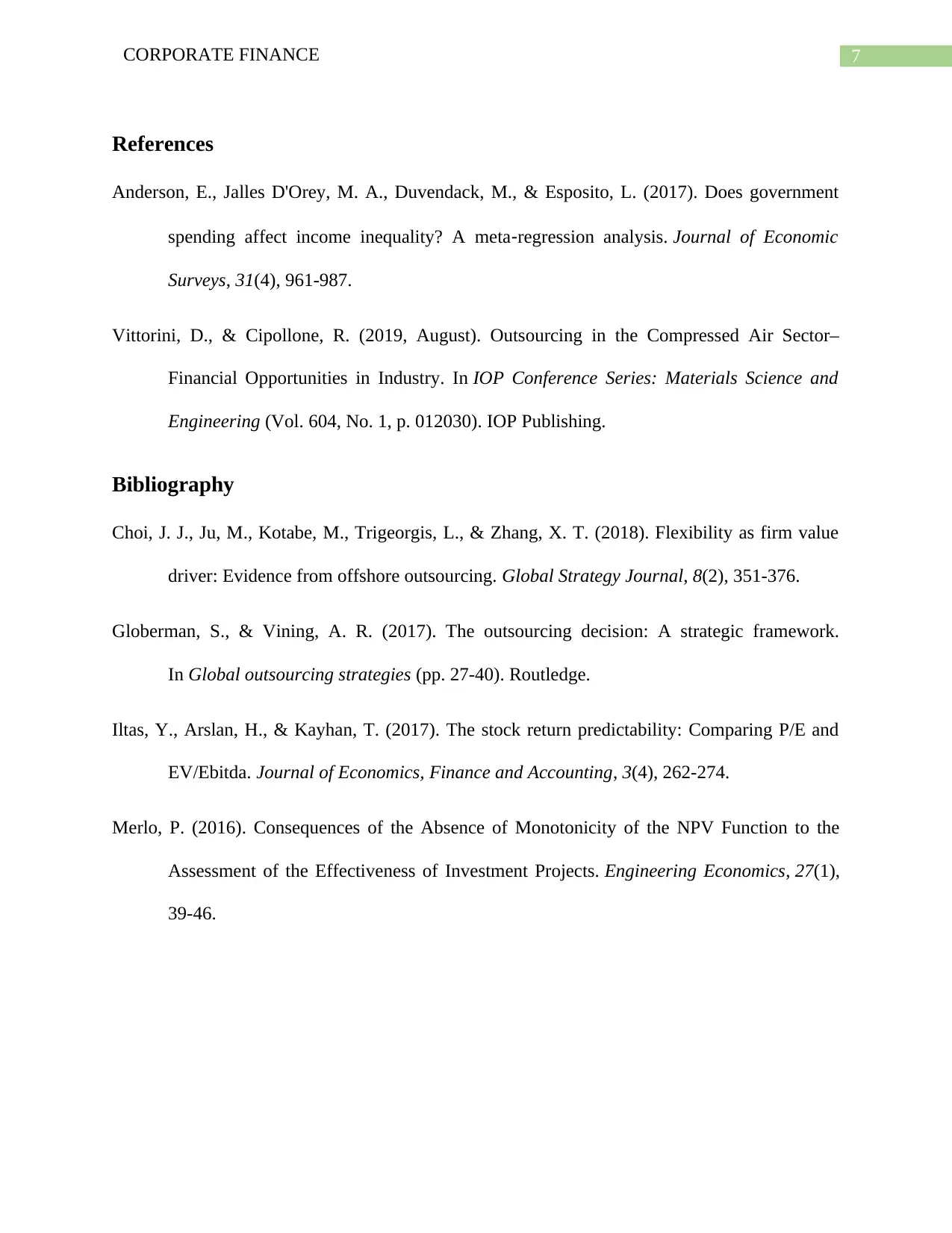
7CORPORATE FINANCE
References
Anderson, E., Jalles D'Orey, M. A., Duvendack, M., & Esposito, L. (2017). Does government
spending affect income inequality? A meta‐regression analysis. Journal of Economic
Surveys, 31(4), 961-987.
Vittorini, D., & Cipollone, R. (2019, August). Outsourcing in the Compressed Air Sector–
Financial Opportunities in Industry. In IOP Conference Series: Materials Science and
Engineering (Vol. 604, No. 1, p. 012030). IOP Publishing.
Bibliography
Choi, J. J., Ju, M., Kotabe, M., Trigeorgis, L., & Zhang, X. T. (2018). Flexibility as firm value
driver: Evidence from offshore outsourcing. Global Strategy Journal, 8(2), 351-376.
Globerman, S., & Vining, A. R. (2017). The outsourcing decision: A strategic framework.
In Global outsourcing strategies (pp. 27-40). Routledge.
Iltas, Y., Arslan, H., & Kayhan, T. (2017). The stock return predictability: Comparing P/E and
EV/Ebitda. Journal of Economics, Finance and Accounting, 3(4), 262-274.
Merlo, P. (2016). Consequences of the Absence of Monotonicity of the NPV Function to the
Assessment of the Effectiveness of Investment Projects. Engineering Economics, 27(1),
39-46.
References
Anderson, E., Jalles D'Orey, M. A., Duvendack, M., & Esposito, L. (2017). Does government
spending affect income inequality? A meta‐regression analysis. Journal of Economic
Surveys, 31(4), 961-987.
Vittorini, D., & Cipollone, R. (2019, August). Outsourcing in the Compressed Air Sector–
Financial Opportunities in Industry. In IOP Conference Series: Materials Science and
Engineering (Vol. 604, No. 1, p. 012030). IOP Publishing.
Bibliography
Choi, J. J., Ju, M., Kotabe, M., Trigeorgis, L., & Zhang, X. T. (2018). Flexibility as firm value
driver: Evidence from offshore outsourcing. Global Strategy Journal, 8(2), 351-376.
Globerman, S., & Vining, A. R. (2017). The outsourcing decision: A strategic framework.
In Global outsourcing strategies (pp. 27-40). Routledge.
Iltas, Y., Arslan, H., & Kayhan, T. (2017). The stock return predictability: Comparing P/E and
EV/Ebitda. Journal of Economics, Finance and Accounting, 3(4), 262-274.
Merlo, P. (2016). Consequences of the Absence of Monotonicity of the NPV Function to the
Assessment of the Effectiveness of Investment Projects. Engineering Economics, 27(1),
39-46.

8CORPORATE FINANCE
You're viewing a preview
Unlock full access by subscribing today!

9CORPORATE FINANCE
Paraphrase This Document
Need a fresh take? Get an instant paraphrase of this document with our AI Paraphraser

10CORPORATE FINANCE
1 out of 11
Related Documents
Your All-in-One AI-Powered Toolkit for Academic Success.
+13062052269
info@desklib.com
Available 24*7 on WhatsApp / Email
![[object Object]](/_next/static/media/star-bottom.7253800d.svg)
Unlock your academic potential
© 2024 | Zucol Services PVT LTD | All rights reserved.





